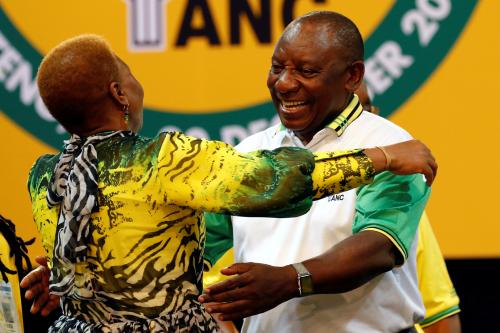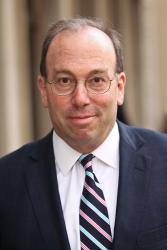United States President Donald Trump’s incendiary August 22 tweet, contending that white farmers are being killed on a “large scale” in South Africa and that farms and other lands are being expropriated, has become part of his well-known toolkit for boosting appeal among his political base while sowing racial discord at home and abroad.
Appropriately, South African President Cyril Ramaphosa hit back at Trump within hours of the tweet, in a clear and forceful message in the Financial Times. The essence of Ramaphosa’s statement is that South Africa is a profoundly unequal society and the distribution of land is at the heart of that inequality, along with education, income, jobs, and skills. As president of South Africa, Ramaphosa has pledged to address this inequality resulting from land dispossession during the colonial and Apartheid eras. In light of the attention on South Africa’s land distribution issue, it is important to present the facts.
What is the land redistribution challenge in South Africa?
The inequality of land distribution in South Africa is rooted in the 1913 Natives Land Act that reserved almost 93 percent of the land for the white minority. This act legalized the historical dispossession of the African population. The 1936 Native Trust and Land Act slightly decreased that share to 87 percent, but the vast inequality of land ownership persists today.
In the constitution that made possible the peaceful transition from apartheid to democracy, it is specified that land should be restituted to the people and communities dispossessed during the colonial and Apartheid eras. According to the Section 25 of the constitution, it stipulates that there should be just and equitable compensation for expropriated land. This section has inspired the “willing-seller, willing-buyer” land redistribution policy of previous governments. Under such a market-based approach, the government would purchase and redistribute land to the dispossessed people and communities. However, progress has been slow at best for many reasons, including property owners who refuse to sell, exorbitant prices, and inadequate dispute resolution mechanisms.
The slow pace of the implementation since the adoption of the new constitution in 1994 led some experts such as South African constitutional law scholar Pierre de Vos to consider the “willing-seller, willing-buyer” policy inefficient, and possibly “unconstitutional because the measures are not reasonable in that they do not allow the state to move as expeditiously as possible to address the effects of past unfair (race-based) land dispossession.”
To address this issue, the parliament passed a bill in 2016, under the presidency of Jacob Zuma, to end the “willing-buyer, willing-seller” approach to land reform. This new bill enabled the government to pay at adjudicator value and expropriate land for the public interest. In 2017, the African National Congress (ANC) adopted a resolution to redistribute land without compensation, which was backed by the parliament for inclusion in the constitution in 2018 and followed by public hearings on amending Section 25 of the constitution.
Today in South Africa, 72 percent of farms and agricultural holdings are owned by whites, who make up 8.2 percent of the population. Black South Africans, who comprise 80.2 percent of the population, own 4 percent of the land.
Why is land distribution important for South Africa?
The World Bank recently published a significant study, Overcoming the legacy of exclusion in South Africa, which contends that a well-managed system of land distribution is essential to redressing the country’s economic inequality. According to the study, the inequality is exacerbated by the limited titling of property, limited access to finance, weak property rights, limited land valorization, lack of sustainable investment, among other factors. The government of South Africa is thus looking to reform its land policy with the hopes of boosting productive land use among the poor to curb rising poverty levels in the country.
According to Statistics South Africa, about 50 percent of South Africans, or 30.4 million people, were poor in 2015. The people suffering the most from inequality, exclusion, and poverty are those with little or no education and skills—children and women, black Africans, and people living in rural areas, such as the Eastern Cape and Limpopo. South Africa therefore has one of the highest levels of inequality in the world, with a particularly high level of unemployment, about 26.7 percent in the last quarter of 2017, and about 50 percent among youths. Boosting the overall productive use of land would be vital to reversing the high unemployment, extreme poverty, and inequality faced in South Africa, including in rural areas which host about 35 percent of the population.
South Africa is globally recognized for its strong constitutional democracy
South Africa has one of the most progressive and admired constitutions in the world, which was negotiated in large part by Ramaphosa under the guidance of Nelson Mandela and other ANC leaders. As such, the comparison to Zimbabwe’s situation made by some observers is misguided. As noted by the U.S. Department of State: “The situation between South Africa and also Zimbabwe is quite different… In Zimbabwe [under former President Robert Mugabe], we saw the government there… destroy(ed) an independent judiciary. And we have not seen that happen in South Africa.”
Trump’s tweets incorrectly suggest that the land distribution process in South Africa is disorderly and unlawful. Land reform in South Africa is an emotive, complex, and important issue, and it is being carried out according to the laws of the country. The Ramaphosa government has committed to making accelerated land reform a priority in a way that previous South African governments have not.
What is next for South Africa and US-Africa relations under Trump?
In his response to Trump, Ramaphosa indicates that the ANC will propose a constitutional amendment that would make explicit the conditions under which land could justifiably be expropriated without compensation, which could include unused land, informal settlements, and abandoned inner-city buildings. While this information is welcome, the ANC needs to come forward with a clear blue-print for addressing land reform as it has in the past with other initiatives. In the aftermath of the ANC’s electoral victory in 1994, the government issued the Reconstruction and Development Plan that set goals for job creation, housing, and electricity. While some goals were met, and others missed, it was tremendously helpful in setting expectations—at home and abroad.
Finally, Trump’s tweet and his other abhorrent comments about Africa do not reflect the larger architecture of U.S.-Africa relations. Programs—such as Power Africa, the Young Africa Leaders Initiative, the African Growth and Opportunity Act, and the proposed BUILD Act aimed at enhancing U.S. investments in the continent—not only have strong bipartisan support in Congress, but also have support from the Trump administration. President Trump could advance U.S.-Africa relations by consulting his own Department of State staff and independent experts who have a deep understanding of issues at play in Africa. This is the time to finally develop a comprehensive U.S. Africa policy.
The Brookings Institution is committed to quality, independence, and impact.
We are supported by a diverse array of funders. In line with our values and policies, each Brookings publication represents the sole views of its author(s).









Commentary
Land redistribution in South Africa, Trump’s tweet, and US-Africa policy
August 27, 2018